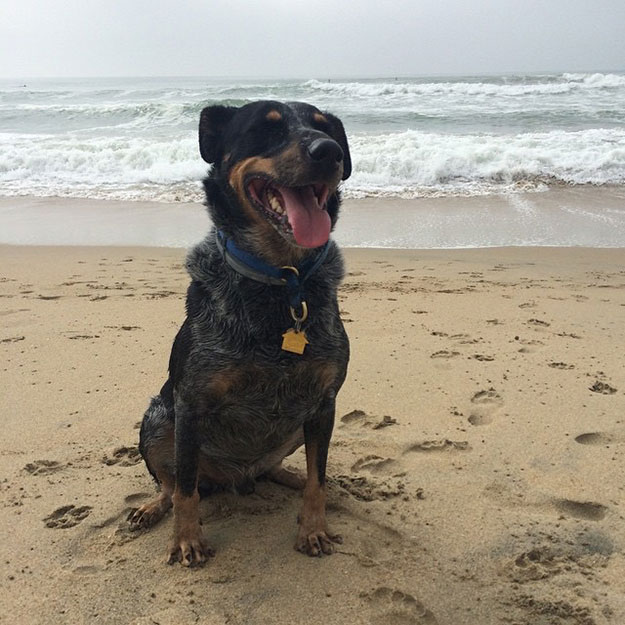As servicemembers begin to enjoy the summer and PCS season, it is important to keep in mind the impacts of hot weather on our pet family members. "Heat injury" is a term used to describe a spectrum of illnesses that occur from increased body temperature. Heat injuries in pets can occur due to activity within hot or humid conditions (ex. playing fetch in the sun) or exposure to an environment with poor ventilation (ex. sitting in a closed car). The most severe type of heat injury is called a heat stroke. This is when body temperature rises too high and causes signs that can include disorientation, shock, blood clotting difficulties, and often death. It is important for all pet owners to understand the serious consequences of heat injuries and how to help prevent them.
 In contrast to people, dogs and cats only have a small amount of sweat glands available to help them stay cool. The majority of these sweat glands are located within the bottom of the paw pads. Other ways used by dogs to stay cool include panting and seeking out areas with cool flooring and shade. Cats also seek out cool and sheltered areas, however, unlike dogs, panting (open mouth breathing) is not a normal behavior.
In contrast to people, dogs and cats only have a small amount of sweat glands available to help them stay cool. The majority of these sweat glands are located within the bottom of the paw pads. Other ways used by dogs to stay cool include panting and seeking out areas with cool flooring and shade. Cats also seek out cool and sheltered areas, however, unlike dogs, panting (open mouth breathing) is not a normal behavior.
Heat injuries occur when a pet's cooling mechanisms are overwhelmed, and all breeds of dogs and cats are at risk.
What heat injury in pets looks like:
- Uncontrolled panting, fatigue, collapse, vomiting or diarrhea, change in gum color (from the normal pink coloration, to blue or bright red), drooling, disorientation, increased thirst, lethargy
Open mouth breathing (panting) is always abnormal in cats, and indicates difficulty breathing. It is recommended to contact your veterinarian immediately if this occurs. For dogs, panting is a normal behavior which helps them stay cool. However, dogs with heat injury often have "uncontrolled panting," which is excessive panting that the pet cannot control or stop. Differentiating between normal and uncontrolled panting is difficult, but can be attempted by offering a panting dog a favorite treat, toy, or water. If the pet will not stop panting to sniff or show interest in these items, they could be experiencing a heat injury, and should be assessed by a veterinarian.
If you notice these signs, move the pet into a well ventilated and shaded area, and immediately contact your veterinarian for further recommendations. Of note, if you think your pet is suffering from a heat injury, do not soak them in cold water. Cold water can actually worsen heat injuries, due to the blood vessels becoming smaller after contact with cold water, which moves blood flow away from the extremities and can result in shivering -- all of which increase body temperature. Professional veterinary care is needed in cases of heat injury, and often includes applying water to the pet and running fans nearby to result in gradual body cooling. This process must be closely monitored, and further veterinary supportive care measures are often needed (ex. intravenous fluid therapy).
Pets at increased risk for developing a heat injury:
- Overweight or obese pets
- Short-nosed ("brachycephalic") dog and cat breeds, to include popular breeds such as pugs and bulldogs
- High-energy/high-activity animals
- Pets that have underlying heart, lung or airway disease
- Pets that are inappropriately acclimated to a new environment or activity
What can you do to prevent heat injury in pets?
- Never leave your pet unattended in a vehicle, even with the air conditioning left on. Pets can become overheated within minutes in a vehicle due to inadequate ventilation, even with the air conditioning running
- Ensure that your pet has access to shaded areas and water at all times, especially during strenuous activity or high temperature/humidity climates
- Acclimate your pet to new environments, to include changes in altitude, temperature and humidity. This can be accomplished by slowly increasing exposure time to these conditions over a two- to three-month period
- Acclimate your pet slowly to increasing activity (ex. walking or running, swimming, playing), and exercise your pet during cooler parts of the day
- Don't forget about preventing heat contact burns and injuries for your pets! If a road or pavement is too hot for you to comfortably hold your hand to for three to five seconds, it is too hot for your pet to walk on it
Summer is a fun time for families and pets to get outside and enjoy the sunshine. Heat injuries in pets are preventable with advanced planning and awareness of the warning signs. If you are concerned that your pet could be at increased risk of heat injury, or would like more information, contact your local family veterinarian.





Read Comments